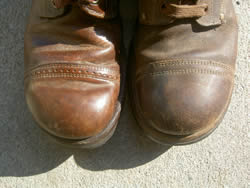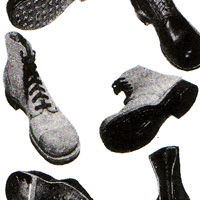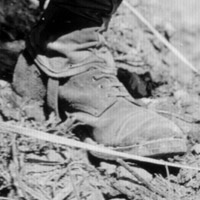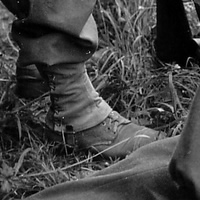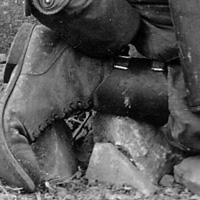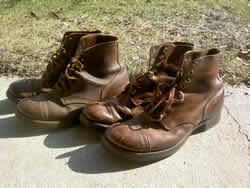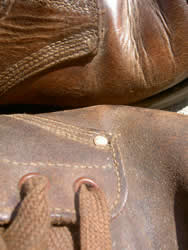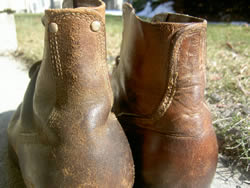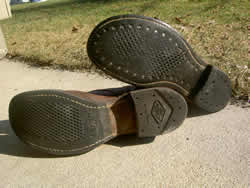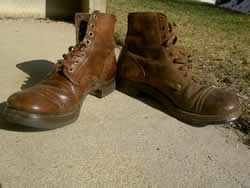Captoe Roughouts: Shoe, Service Type III: The other roughout boot
Date: 3/12/2010
Author: Chris Guska
Editor: Mike Ellis
Research Assistance: Dwayne (Quartermaster)
Background:
I've owned several pairs of original Shoes, Service Type III (aka: Captoe Roughouts) over the years and have always had a fond view of them. Captoe Roughouts have been described within the reenactment community as "extremely rare", or "not issued in significant numbers" or "they don't exist" - but I have an entirely different take on them. Lets take a look.
From the Army’s standpoint, there were three types of boots:
Shoes, Service, Composition Sole (captoes)
Shoes, Service, Reverse Upper (roughouts)
Boots, Service, Combat (double buckles)These three models were recognized due to their major differences. Oddly, there has been a fourth boot to appear on the scene; the "captoe roughout". Original examples of this boot appear similar to the prewar russet service shoe, but with a more modern sole (all rubber), and in roughout leather. It's long been assumed that the plain-toe roughout was the only model to exist. Worst of all, the quartermaster history only mentions the following:
"Samples of improved shoes had been developed earlier by the OQMG, and these were submitted to the Chief of Staff on 5 February (1943). A decision was reached to change production as soon as possible from the Type II service shoe to a new Type III shoe. The latter was to be made with flesh-out upper leather and a full rubber sole and heel, which, with the scarcity of rubber, was later changed to reclaimed and then to synthetic rubber. The use of flesh-out Army retan had been decided on because it was more durable, it absorbed dubbing more readily, thereby increasing the qualities of flexibility and waterproofing, and it was more comfortable in the breaking-in stage than grain-out leather."
From The Quartermaster Corps: Organization, Supply and Services Volume 1 by Erna Risch (page 104.) - Research courtesy of Dwayne (Quartermaster)
So what gives? There is no mention of a cap toe, and some have used this as evidence against it. This is not the case - the cap toe isn't mentioned because it was unchanged from the prewar specification! In other words, the earliest roughouts had more in common with service shoes than most people will admit. It wasn't until later that the cap toe was dropped to help production.
From a collector’s standpoint then, there are FOUR types of infantry boot:
Type II (aka, "Service Shoes", or "Shoes, Service, Composition Sole")
Type IIIa (aka, "Captoe Roughouts", or "Shoes, Service, Reverse Upper")
Type IIIb (aka, "Roughouts", or "Shoes, Service, Reverse Upper")
Combat Boot (aka, "Double Buckles", or "Boots, Service, Combat")The Quartermaster Catalogs provide an interesting validation to this point, such that the "Shoes, Service, Reverse Upper" are illustrated as the captoe roughout variety as initally procured - while the caption for those same boots indicates that they do not have a cap toe. Its interesting that the picture remains constant through all revisions of the QM catalog through 1946, showing the initial captoe version of the "Shoes, Service, Reverse Upper"
With the above knowledge, that the initial production runs of Shoes, Service, Reverse Upper were actually of the captoe variety - it begins to raise some questions of our perceptions on "Captoe Boots" in period photos. While it may be often difficult to difinitively discern, I contend that some of the photos that have been commonly attributed to "Service Shoes" are actually Captoe Roughouts.
Variant: The Captoe Roughout Buckle Boot
There were a significant number of Shoes, Service Type III contracted prior to the pattern being simplified to what we commonly think of as "Roughouts" and finally the Combat Boot.
"Deliveries of the Type III shoe began April 1943. By July, experimentation on the combat boot as a replacement for the Type III shoes was fairly well advanced. Field tests reports were favorable and on 16 November 1943 the QMCTC approved a committee report calling for standardization of the combat boot. A few days later this recommendation was concurred in by the ASF. By January 1944 the shoe industry began production of the combat boot for regular issue."
"At the time it was also decided to produce a new combat shoe in limited quantities for test purposes. The boot was the same as the shoe, plus a cuff and buckle top which gave it a 10 inch height as compared to the 6 inches for the Type III shoe. The boot was intended to eliminate the shoe and legging combination worn by infantrymen and the special book worn by parachute troops.
From The Quartermaster Corps: Organization, Supply and Services Volume 1 by Erna Risch (page 104.) - Research courtesy of Dwayne (Quartermaster)
Author's Note:
Some Type III service shoes were completed as or converted to combat boots prior to the adoption of the Combat Boot as we know it. While this article does not address this variant, I think it is still worthy of mention and illustration.Above are Captoe Buckle Boots as described in the quote. The left boot is subtle - but the right boot is clear. The other soldier in the photo also appears to have some form of captoe roughout, unsure if they are captoe buckle boots or not.
About the Boots:
Lets start off with some direct comparisons between the Type II and Type III service shoes.
1.) The boots are made with the flesh/roughout leather exposed rather than the smooth side
2.) The captoe is not embellished with holes between the 2 lines of double needle stitching
3.) The vamp is secured to the uppers via a rivet on both sides, much like the later roughout boots
4.) The backstay is secured at the top to the upper with a pair of rivets
5.) The sole is a "fullsole" on the Type III's and the Type II's has a halfsole. The Type III features a welted and fully nailed fullsole.
Page 2: The Project
Page 3: The Conversion
Page 4: Comparisons and Conclusions
90th IDPG Projects



